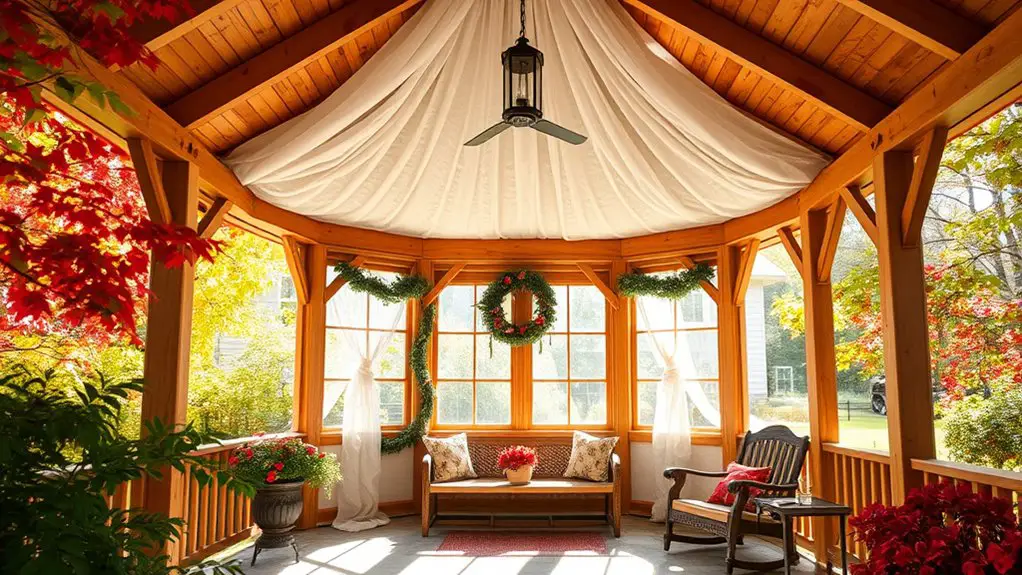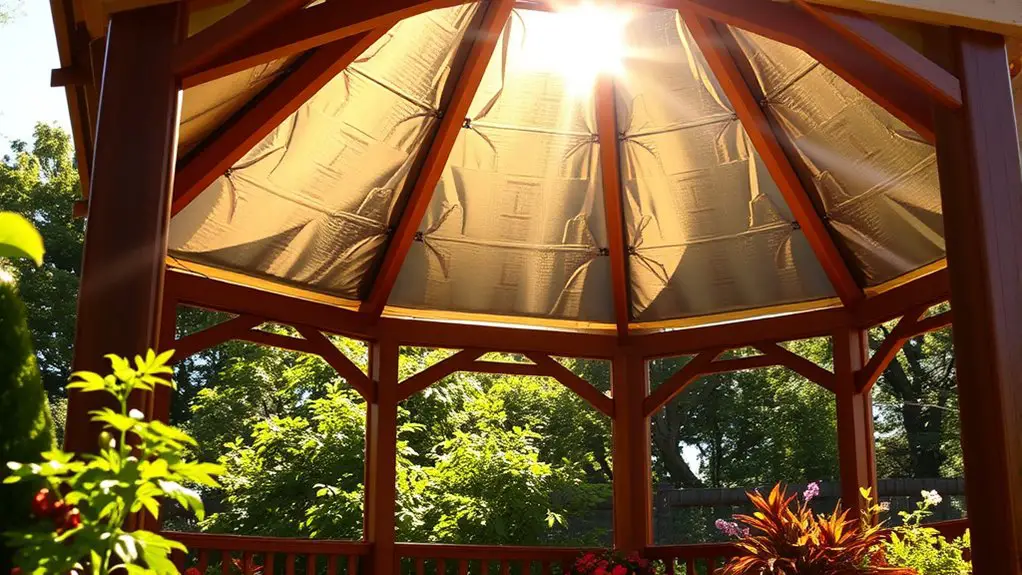To achieve an energy-efficient gazebo, consider insulation options like fiberglass for cost-effectiveness, or spray foam for superior energy efficiency with its high R-value. Reflective insulation is ideal for sunny climates, while mineral wool offers fire resistance and eco-friendliness. Rigid foam is durable and moisture-resistant, and cellulose provides sustainable thermal resistance. Each material has unique benefits, so evaluating costs and performance is essential. Explore more options and factors to find the best fit for your gazebo.
Understanding the Importance of Insulation in Gazebos

While you might think of gazebos as simply outdoor structures for relaxation, understanding the importance of insulation can greatly enhance their functionality and comfort. Insulation benefits extend beyond mere temperature regulation; they also contribute to energy efficiency and durability. By effectively insulating your gazebo, you can maintain a more stable gazebo temperature, ensuring a comfortable environment year-round.
Proper insulation prevents heat loss during cooler months and minimizes heat gain in the summer, allowing you to enjoy your space without excessive reliance on heating or cooling systems. Additionally, effective insulation can reduce noise pollution from the surrounding environment, creating a more serene atmosphere.
Incorporating quality insulation materials can ultimately lead to lower energy costs and a more enjoyable outdoor experience, making your gazebo not just a leisure area, but a versatile extension of your living space. Embracing these insulation benefits can redefine how you interact with your outdoor oasis.
Fiberglass Insulation: A Popular Choice
Fiberglass insulation stands out as a cost-effective option for your gazebo, balancing affordability with performance. Its installation process is straightforward, making it accessible for DIY enthusiasts and professionals alike. By considering fiberglass, you can achieve effective thermal regulation without breaking the bank.
Cost-Effective Insulation Option
When looking for a cost-effective insulation option for your gazebo, fiberglass insulation stands out as a reliable choice. This material is not only known for its thermal efficiency but also its affordability, making it one of the most budget-friendly solutions available. Fiberglass insulation effectively minimizes heat transfer, helping maintain a comfortable temperature year-round. Its lightweight nature simplifies handling and installation, which is an added benefit for DIY enthusiasts. Additionally, it’s manufactured from recycled materials, enhancing its appeal as an eco-friendly option. By opting for fiberglass, you’re investing in an insulation solution that balances cost and performance, ensuring your gazebo remains a welcoming space without breaking the bank. Choosing fiberglass insulation aligns perfectly with your desire for both efficiency and freedom.
Easy Installation Process
If you’re considering insulation for your gazebo, the easy installation process of fiberglass insulation can greatly simplify your project. This material is lightweight and flexible, allowing you to cut it easily to fit your specific dimensions. When using fiberglass, it’s important to take proper safety precautions, like wearing a mask and gloves. For best results, follow these installation tips: verify your frame is clean, use a vapor barrier to prevent moisture buildup, and secure the insulation with staples or adhesive. Employing effective insulation techniques will help create a comfortable environment year-round. With a bit of preparation, you’ll find that fiberglass insulation not only boosts energy efficiency but also enhances your gazebo’s overall functionality.
Spray Foam Insulation: Superior Energy Efficiency

Spray foam insulation offers numerous advantages, particularly in energy efficiency, that you might find compelling for your gazebo. Its application process involves expanding foam that fills gaps and creates an airtight seal, which greatly reduces temperature fluctuations. Over time, these benefits can translate into substantial long-term cost savings on energy bills.
Advantages of Spray Foam
Although many insulation options exist, spray foam stands out due to its exceptional energy efficiency. The spray foam benefits include superior insulation performance and the ability to expand, filling gaps and cracks effectively. This results in reduced energy costs and a more comfortable environment in your gazebo.
| Spray Foam Benefits | Impact on Insulation Performance |
|---|---|
| High R-value | Maximizes thermal resistance |
| Air sealing capabilities | Minimizes air leakage |
| Moisture resistance | Prevents mold and mildew |
| Sound dampening properties | Enhances acoustics |
| Long-lasting durability | Reduces need for frequent replacements |
Choosing spray foam insulation for your gazebo is a wise investment, ensuring a cozy space that thrives in energy efficiency.
Application Process Explained
Understanding the application process for spray foam insulation is essential for maximizing its benefits in your gazebo. First, select quality insulation materials tailored to your region’s climate. Preparation is key; make sure surfaces are clean and dry. Next, employ effective installation techniques—this often involves using a spray gun to apply the foam evenly across surfaces. Pay attention to the recommended thickness to achieve the best insulation performance. It’s advisable to wear protective gear during application, as chemicals can be hazardous. After application, allow the foam to cure fully, which can take several hours. Properly following these steps guarantees a well-insulated gazebo, enhancing energy efficiency while providing a comfortable space to enjoy.
Long-Term Cost Savings
By investing in spray foam insulation for your gazebo, you can reveal significant long-term cost savings due to its superior energy efficiency. This insulation type minimizes energy loss, leading to lower heating and cooling costs. When considering long-term investments, spray foam stands out for its durability and performance.
Here’s a comparison of insulation options:
| Insulation Type | Initial Cost | Energy Savings Potential |
|---|---|---|
| Spray Foam | Higher | Excellent |
| Fiberglass | Moderate | Good |
| Cellulose | Lower | Fair |
Choosing spray foam not only enhances your gazebo’s comfort but also guarantees enduring savings. Over time, the reduced utility bills will far outweigh the initial investment, making it a wise financial decision.
Reflective Insulation: Keeping the Heat Out

Reflective insulation serves as a powerful tool in the fight against heat accumulation in gazebos. By utilizing reflective barriers, this insulation type effectively bounces radiant heat away during the hot months, maintaining a more comfortable environment. When installed properly, it works best in conjunction with other insulation materials, as it tackles heat reflection while minimizing the heat that penetrates through the walls and roof.
You’ll find that reflective insulation is particularly advantageous in sunny climates, where it can greatly reduce cooling costs. Its lightweight nature also simplifies installation, allowing you to enhance your gazebo’s energy efficiency without extensive renovations. Additionally, reflective insulation can contribute to a healthier outdoor experience, keeping the space cooler for relaxation or entertaining.
Mineral Wool Insulation: Fire Resistant and Eco-Friendly
Mineral wool insulation stands out as an excellent choice for gazebo construction due to its fire-resistant properties and eco-friendly composition. When you consider the insulation benefits, it becomes clear why mineral wool is a top contender. Here are four key advantages:
Mineral wool insulation offers fire resistance and eco-friendliness, making it an ideal choice for your gazebo.
- Fire Resistance: Mineral wool can withstand high temperatures, making it a safe choice for structures exposed to heat sources.
- Eco-Friendly: Made from natural materials, it’s a sustainable option that minimizes environmental impact.
- Sound Absorption: Its dense structure dampens noise, creating a peaceful atmosphere in your gazebo.
- Moisture Resistance: Mineral wool doesn’t absorb water, preventing mold and mildew growth, which is essential for longevity.
Rigid Foam Board Insulation: Durability and Performance
When constructing a gazebo, choosing the right insulation is essential for maintaining comfort and energy efficiency, and rigid foam board insulation delivers exceptional durability and performance. This material boasts impressive insulation properties, providing a high R-value per inch, which effectively resists heat transfer. You’ll appreciate the moisture resistance of rigid foam, helping to prevent mold and structural damage over time.
Rigid foam boards are lightweight yet robust, making them easy to handle during installation. Their closed-cell structure enhances their durability, allowing them to withstand various environmental conditions without sagging or degrading. The versatility of rigid foam also means it can be cut to fit any space, ensuring a snug fit that maximizes thermal performance. By incorporating rigid foam insulation into your gazebo, you’re investing in a lasting solution that enhances comfort and energy efficiency, giving you the freedom to enjoy your outdoor space year-round.
Cellulose Insulation: Sustainable and Effective
While rigid foam board insulation offers durability and high performance, cellulose insulation presents an equally compelling option, particularly for those prioritizing sustainability. This eco-friendly material is made from recycled paper products, making it a smart choice for energy-efficient gazebos. Here are some cellulose benefits worth considering:
- Sustainability: Using recycled materials reduces environmental impact.
- Air Quality: Cellulose installation can improve indoor air quality by resisting mold and pests.
- Thermal Performance: It provides excellent thermal resistance, keeping your gazebo warm in winter and cool in summer.
- Sound Absorption: Cellulose acts as a sound barrier, enhancing the overall comfort of your space.
Comparing Costs and Benefits of Insulation Options
Evaluating insulation options for your gazebo involves balancing costs and benefits to determine what best meets your needs and budget. Conducting insulation comparisons can help you make informed decisions that enhance energy efficiency while managing expenses. Below is a cost analysis of common insulation materials:
| Insulation Type | Estimated Cost per Sq Ft | R-Value | Sustainability |
|---|---|---|---|
| Fiberglass | $0.50 – $2.00 | 2.9-4.3 | Moderate |
| Foam Board | $1.00 – $3.00 | 3.9-6.5 | Low |
| Cellulose | $0.80 – $2.50 | 3.2-3.8 | High |
| Spray Foam | $1.50 – $4.00 | 5.0-6.5 | Moderate |
Each option carries distinct advantages. For example, while spray foam offers superior insulation, its higher cost might not fit every budget. By weighing these aspects, you’ll find the right balance for your gazebo’s insulation needs.
Frequently Asked Questions
Can I Install Insulation in My Gazebo Myself?
Installing insulation in your gazebo yourself can symbolize your independence. With the right DIY insulation and installation tools, you can transform your space, enhancing comfort and energy efficiency, while enjoying the freedom of personal craftsmanship.
How Does Insulation Affect Gazebo Maintenance?
Insulation greatly impacts gazebo maintenance costs. By improving energy efficiency, it reduces heating and cooling needs, potentially lowering utility bills. Additionally, it helps prevent moisture buildup, minimizing repairs and prolonging the structure’s lifespan, offering long-term benefits.
What Are the Environmental Impacts of Different Insulation Materials?
Oh sure, let’s just insulate with unicorn tears! In reality, sustainable insulation made from recycled materials greatly reduces environmental impacts, lowering waste and resource consumption, while enhancing your space’s efficiency. Choose wisely; Mother Earth appreciates it!
How Long Does Insulation Typically Last in a Gazebo?
Insulation lifespan in a gazebo typically ranges from 10 to 50 years, depending on materials and environmental conditions. Choosing quality insulation can considerably enhance gazebo durability, ensuring it withstands the elements while maintaining energy efficiency.
Can Insulation Help With Noise Reduction in Gazebos?
Imagine you’re enjoying a quiet evening in your gazebo, but outside noise disrupts the peace. Utilizing soundproofing techniques with acoustic materials can greatly reduce noise, enhancing your relaxation and creating a serene retreat.

